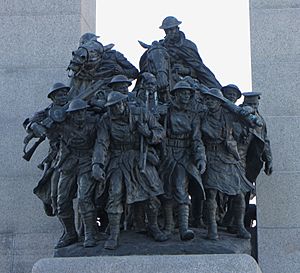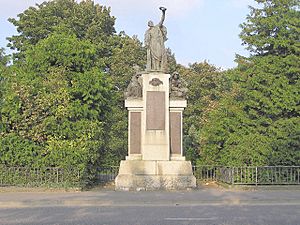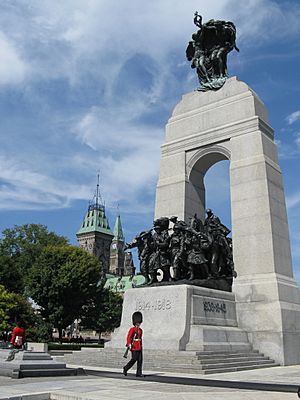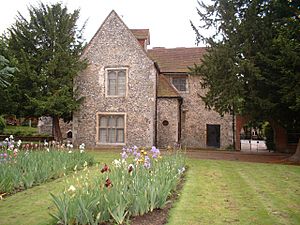Elsie March facts for kids
Quick facts for kids
Elsie March
|
|
|---|---|

Two service-women are included among the bronze figures of the National War Memorial.
|
|
| Born | 3 October 1884 Kingston upon Hull, England
|
| Died | 1974, Second quarter Kent, England
|
| Nationality | British |
| Known for | Sculpture, Metalwork, Painting |
|
Notable work
|
"National War Memorial of Canada" "Portrait of Harry Geoffrey Beasley" "Mother and Child" |
| Awards | Lady Feodora Gleichen Fund |
Elsie March (born 3 October 1884 – died 1974) was a talented English sculptor. She was one of eight artists in her family! After her brother Vernon March passed away, Elsie and her other brothers worked together to finish the important National War Memorial of Canada in Ottawa, Ontario. Early in her career, Elsie also focused on creating beautiful metalwork and paintings.
Contents
A Family of Artists
Elsie March was born in Kingston upon Hull, England. Her parents were George Henry March and Elizabeth Blenkin. Her father worked with seeds and oils in Yorkshire.
By 1901, the family had moved to Battersea in London. Elsie was the seventh of nine children. What's amazing is that eight of them became artists! Three of them were sculptors: Sydney, Elsie, and Vernon. The other five artist siblings were Edward, Percival, Frederick, Dudley, and Walter.
In 1911, all nine siblings, who were still single, lived together in their large 17-room family home called Goddendene. This home was in Locksbottom, Farnborough, Kent.
Elsie's Art Career
After 1901, Elsie and her brothers built three big art studios at their family home, Goddendene. They even had a metal foundry there! The studios were designed with walls that could slide open. This allowed the artists to work in natural light. They were also tall enough to be used during wartime to hang parachutes for drying.
The March siblings worked together on many sculptures. One of their most famous projects was "The Response", which is the National War Memorial of Canada in Ottawa. In 1925, there was a worldwide competition to design this memorial. Vernon March was chosen from 127 artists to create the design. He won the job in January 1926 with his idea called "The Great Response of Canada." Sadly, Vernon died in 1930 before the monument was finished.
Elsie and five of her brothers stepped in to complete the bronze statues for the memorial. They first shaped the figures in clay. Then, they made plaster copies. Finally, they created the bronze statues at their studio foundry in Goddendene. They finished this huge task by July 1932.
The bronze figures were so important that they were displayed in Hyde Park in London for six months! After that, they were stored at the Goddendene studio. In 1937, the figures were sent to Ottawa. There, the memorial's base and arch were built. Members of the March family helped direct the building of the granite monument. The entire memorial, including the bronze figures, was completed on 19 October 1938.
The National War Memorial of Canada remembers the brave Canadians who fought in World War I. King George VI officially revealed it on 21 May 1939. About 100,000 people came to watch the ceremony! Vernon's design included large bronze statues of Victory and Liberty on top of an arch. Under the arch, there are 22 bronze figures. These figures represent the different parts of the Canadian military during the First World War. Two of these figures are service-women.
The March family also created smaller artworks. Elsie March sculpted a bronze portrait of Harry Geoffrey Beasley, who was a British anthropologist. This sculpture, from April 1939, is now in the British Museum. Elsie also created a large sculpture of Sir Winston Churchill. Other works by Elsie include a bust of Lawrence of Arabia (from 1936), a bust of Beethoven (from 1920), and a portrait called "Wendy" (from 1953). When she first started her career, Elsie often painted portraits and made beautiful items from metal, like silver, sometimes decorated with colorful enamels.
Elsie March showed her art at several exhibitions. In 1919, she displayed two works at the Royal Glasgow Institute of the Fine Arts. She also showed her art nine times at the Royal Academy summer exhibition. In 1943, she won the Lady Feodora Gleichen prize for her terracotta statue called "Mother and Child."
Bronze Figures of the National War Memorial
Other Works by the March Family

The March family worked together on many other monuments. One of their first was the Royal Inniskilling Fusiliers South African War Memorial. All the March artists helped create this memorial. It honored the soldiers who died in the Boer War. The family even installed it themselves in 1902! The monument was first in Omagh, County Tyrone. It was moved in 1964 because it was causing traffic problems.
Another project was the Lewes War Memorial in East Sussex. Vernon March was the main sculptor for this one. The memorial has a tall stone monument with a bronze winged Victory statue on top. This statue holds a laurel wreath. Other bronze angels sit at the base, next to shields with the names of soldiers who died in World War I. This monument was revealed on 6 September 1922. It was updated in 1981 to also remember those who died in World War II.
The war memorial at Sydenham, London remembers soldiers from World War I and II. These soldiers worked for a gas company. The monument has a bronze figure of Victory. It also has bronze plaques listing the names of the fallen soldiers. Sydney March was the main sculptor for this memorial. It was revealed on 4 June 1920. Sadly, in October 2011, three bronze plaques were stolen from the monument.
Later Life and Legacy
Elsie March passed away in 1974 in Kent, England, at the age of 89. She was the last of the March siblings to live. Most of her family, including her parents, are buried at Saint Giles the Abbot Churchyard in Farnborough. Their grave has a bronze angel monument that her brother Sydney March sculpted in 1922. Elsie's ashes were buried there on 7 June 1974.
The March family's work is still remembered today. In 2011, a historian gave a talk about them, showing photos of their home and the bronze figures of the National War Memorial of Canada. Also in 2011, an exhibition of local artists' work was held at the Bromley Museum in The Priory in Orpington. This exhibition included small models made by the March artists.
You can see Elsie March's bust of Sir Winston Churchill at the Bromley Library. Her bust of Harry Geoffrey Beasley is at the British Museum in London. There's even a silent black and white movie from 1924 that shows the March artists working in their studios at Goddendene! This film has been shared by British Pathé.





